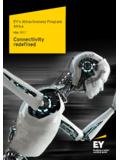Transcription of BitcoinMininganditsEnergyFootprint
1 ISSC 2014 / CIICT 2014, Limerick, June 26 27 Bitcoin Mining and its Energy FootprintKarl J. O Dwyer and David Malone Hamilton InstituteNational University of Ireland MaynoothE-mail: Bitcoin is a digital cryptocurrency that has generated considerable publicinterest, including both booms in value and busts of exchanges dealing in of the fundamental concepts of Bitcoin is that work, called mining, must be donein checking all monetary transactions, which in turn creates Bitcoins as a reward. Inthis paper we look at the energy consumption of Bitcoin mining. We consider if andwhen Bitcoin mining has been profitable compared to the energy cost of performingthe mining, and conclude that specialist hardware is usually required to make Bitcoinmining profitable. We also show that the power currently usedfor Bitcoin mining iscomparable to Ireland s electricity BitcoinI IntroductionBitcoin is a peer-to-peer cryptocurrency mainlyused for monetary transactions on the Internet [1]and is designed to be similar to fiat money andcommodities.
2 Bitcoins are intrinsically valueless,their worth is decided by those trading in the time of writing, 1 Bitcoin (B) is worth ap-proximately Euro(e). Bitcoin has generateda huge amount of interest in the media lately andhas sparked a wave of copy-cat-currencies (Lite-coin, Gaelcoin, etc.) and even a fully working par-ody currency (dogecoin). It has also generated in-terest in academic circles due to issues it createsin user privacy [2], as well as attempts to gaininsights into is behind transactions [3] and at-tempts to better understand its implications as apayment system [4].Bitcoin is based on a peer-to-peer networkwithin the Internet. The members of the peer-to-peer network effectively maintain a ledger of Bit-coin transactions which have been accepted by thenetwork. In this ledger, Bitcoins are owned byBit-coin addresses, which are public keys from a key-pair.
3 In order to assign Bitcoins, or some fractionthereof, to a new owner, the current owner mustsign the transaction with the private key of thekeypair using an ECDSA scheme. Before a trans-action is accepted by the network, the transactionis checked for validity, including the presence ofthese are not issued or governed by a cen-tral authority but, instead are created in a processcalledmining. Mining is one of the key conceptsbehind the Bitcoin protocol, in which valid trans-actions are collected intoblocksand are added tothe ledger by linking it to the previously acceptedblocks. The network forms a common view, calledtheblockchain, of which transactions have takenplace, preventing users from reusing Bitcoins andattempting to spend them more than add a block to the blockchain, a signaturemust be found linking the transactions in the blockto the previous blocks.
4 This requires finding anoncevalue which satisfies a particular equationinvolving the SHA256 cryptographic hash func-tion. This is a computationally expensive task;however, a member of the peer-to-peer networkwho finds a suitable value is rewarded by beingable to assign newly mined Bitcoins to an addressof their this paper we consider the energy cost of Bit-coin mining. Solving of the computational prob-lem requires energy. We consider how this energycan be calculated and the impact of using differenttypes of hardware for this computation. Using his-torical information from the Bitcoin network andBitcoin exchanges, we compare the monetary costof the energy to the reward for calculating a Bit-coin block. We also consider the likely power con-sumption of the whole Bitcoin mining operation,and show that it is comparable to Ireland s averageelectricity Bitcoin MiningAs we mentioned, a Bitcoin miner is part of Bit-coin s peer-to-peer network that collects recenttransactions and aims to complete a proof of workscheme, based on the ideas of Hashcash[5].
5 In thisscheme, there is a current target valueT, which isperiodically recalculated by the network (see Sec-tion )). The miner s aim is to find a nonce valueso thatH( )< T(1)whereBis the string representing the recent trans-actions,Nis the nonce value, . is the concatena-tion operator andHis the Bitcoin hash function,in this caseH(S) := SHA256(SHA256(S)).The proof of work can be achieved by choosingvalues forNrandomly or systematically until satisfied. When anNis found, the resultingblock can be sent to the Bitcoin network and addedto the Bitcoin blockchain. Finding a block resultsin a reward of extra Bitcoins for the block s , the process of finding a suitableNvalue isreferred to asBitcoin ) DifficultyThe rate at which Bitcoins can be discovered canbe controlled by the Bitcoin Network s choice ofthe value of the target,T, in However, thetarget depends on the current number and speedof miners in the Bitcoin network, and is normallyquoted in terms of thedifficulty,D.
6 The relation-ship between the difficulty and the targetTisD=TmaxTwhere the largest possible value of the targetTmaxis (216 1)2208 hash functionHfor Bitcoin has been chosenso that it behaves approximately as a uniformlyrandom value between 0 and 2256 1. Thus, for anygiven nonce value, the probability of it isp=T2256=TmaxD2256 nonce value tested should behave like an in-dependent trial, so the number of trials until a201020112012201320141001011021031041051 061071081091010 DifficultyDifficulty Over TimeFig. 1: The change of the difficulty to generate a Bitcoinover time, based on aggregated statistics [6].block is successfully completed will be geometri-cally distributed, therefore the the expected num-ber of hashes to find a block isD232. If we have asystem calculating hashes at a rateR, the expectedtime to find a block isE[t] =1p D232R.(2)For example, if you can calculate a Bitcoin hash1 million times a second, and the difficulty is4,250,217,9201, thenE[t] ) Change in DifficultyThe difficulty,D, is recalculated every 2016 blocks,with the aim of keeping the average time to dis-cover a new block near 10 minutes.
7 At this idealspeed, 2016 blocks will be discovered every twoweeks. To calculate the new difficulty, the lengthof time that it took to calculate the the last 2016blocks is used to estimate the hash rate of the en-tire Bitcoin network. The new difficulty is selectedso that if the same average hash rate is maintained,it will take two weeks to calculate the next 2016blocks. If the resulting difficulty is more than fourtimes harder (or four times easier) than the cur-rent difficulty, then the result is capped to fourtimes harder (or easier). Restrictions on the rangeof acceptable difficulties/targets are also historical values of difficulty to date are shownin Figure 1. The increasing trend in difficulty hasbeen caused by an increase in the resources dedi-cated to calculating hashes in the Bitcoin ) Change in RewardThere are two sources of reward for calculating anew block.
8 First, the block is formed from Bit-coin transactions, and a transaction may chooseto include a transaction fee, to be paid to who-ever finds a block containing this transaction. Sec-1 Current as of mid March 2013 May 2013 Jun 2013 Jul 2013 Aug 2013 Sep 2013 Oct 2013 Nov 2013 Dec 2013 Jan 2014 Feb 2014 Mar Transaction CostFig. 2: The average transaction fee per block per derived , a standard reward is provided depending onhow many blocks have been successfully calcu-lated. This reward started atB50 per block andis halved every 210,000 blocks. As of mid-March2014, the reward isB25. The reward will eventu-ally reachB0; after such time it is imagined thatthe network of miners will continue mining but willdo so in order to gain processing fees. This meansthat there is a limit on the number of Bitcoinswhich will be mined, but each Bitcoin is divisibleup to 8 decimal mean value of the transaction fee over aday is plotted for a range of days in Figure 2.
9 Aswe can see the current standard reward,B25, isconsiderably larger than the current or historicalaverage transaction fees. This may change in thefuture, as the standard reward continues to Hardware Arms RaceThe major limiting factors in Bitcoin mining arethe hash rate of hardware and the cost of runningthis hardware. The hash rate,R, is typically mea-sured in millions of hashes per second or Mega-hashes (Mhash/s). This is combined with thepower usage,P, of the hardware to get the energyefficiency of the hardwareE=R/P(Mhash/J)which serves as a helpful statistic to compare hard-ware. Statistics are shown for a selection of hard-ware in Table mining took place on normal2comput-ers. As Bitcoin gained popularity, there was some-thing akin to an arms race as miners attemptedto increase their hash rate. Graphics Process-ing Units (GPUs) which can perform many par-allel calculations are well-adapted to Bitcoin min-ing.
10 Standard programming interfaces, such asOpenCL or CUDA, made GPUs popular among2 Where normal is defined as a general purpose com-puter, such as an IBM PC type architecture with an 2010 Mar 2011 Jul 2011 Nov 2011 Mar 2012 Jul 2012 Nov 2012 Mar 2013 Jul 2013 Nov 2013 Mar 2014020040060080010001200 USDBTC to USD Exchange Rate ( )Fig. 3: The exchange rate between Bitcoin and Dollars,based on aggregate statistics [6].Bitcoin miners. Their higher hash rate comparedwith their lower energy footprint made them bet-ter suited to mining than normal the use of GPUs became more widespread,people were forced to look for alternatives to keepahead of the crowd. Field Programmable GateArrays (FPGA) came into vogue for a brief pe-riod before Application Specific Integrated Cir-cuits (ASIC) came onto the scene. ASICS can per-form the Bitcoin hash at higher rates but with amuch smaller energy requirement.





